My name's Lori Stout, and in this article, I want to share my experiences as a PMM in different organizations over the years and discuss why I believe it is well past time for us to take our seat at the strategy table as product marketers.
I’ll focus on a variety of topics, including:
Plus, I'll discuss ways to get your seat at the strategy table.
Background & context
I've been a marketer for a little over 15 years and got my start in customer marketing. I've worked in content marketing, solutions marketing, and spent the bulk of my career as a product marketer.
One thing that some of you might be able to relate to is that over the course of my career, as I've moved from organization to organization, that role as a product marketer has looked a little bit different.
Whether it's where product marketing sits in the organization or the goals and objectives that are set for product marketing, every business has a little bit of a different spin on how they look at product marketing.
I'll talk about that a little bit as I go through this article, and frame how we can use our experience as subject matter experts to really position ourselves as strategists in the company.
Punchh
I'm currently the Senior Director of Product Marketing at a company called Punchh. If you're not familiar with us, we're about 11 years old, based in Silicon Valley.
We are the leader in customer loyalty offers and engagement. If you have a favorite restaurant brand, you have their loyalty app on your phone, and you collect rewards and engage with the brand in that way, odds are good that we had something to do with building that loyalty program.
It's a great space to be in. We're really seated firmly in the customer experience space, which I really enjoy.
The role of product marketing
As I was thinking about what I wanted to write about, I found a statistic from the Product Marketing Alliance 55 Product Marketing stats for 2020. It's kind of a shocking statistic when you see it in print, but it's also one that really held true for me.
Just 5% of product marketers say the other teams and stakeholders really understand what they do, and what their role is inside the organization.
Of course, that means 95% of us don't feel like the organization and our colleagues really understand what we do and the value we bring to the business.
The weird contradiction to this is we collaborate with more cross-functional teams than probably any other department in the company.
We are the eyes and ears for everything that's happening in the business and bringing that all back together to that innovation strategy.
It’s time to make a shift
My friends, it is time for us as product marketers to make that shift from simply saying yes, to asking why, when it comes to innovation and strategy.
Instead of being handed this fully baked roadmap and being told to go execute, we really need to assert ourselves and become more involved earlier in the process so we are there with market research and competitive research in hand before the roadmap is even a twinkle in your engineering team's eye.
Three reasons why product marketing deserves a seat at the table
There are a lot of different reasons why but here are three I want to cover.
- First of all, we have a unique 360-degree view of the organization that nobody else has.
- Secondly, we help bridge that gap between innovation and what we think we need to build between what we actually need to build and what the market will support and will respond to.
- Last but not least, and this one has been hotly contested through the years, marketing has traditionally been lumped into that cost center bucket but we have the tools, technologies, and metrics now to really prove ourselves as a growth center instead of a cost center.
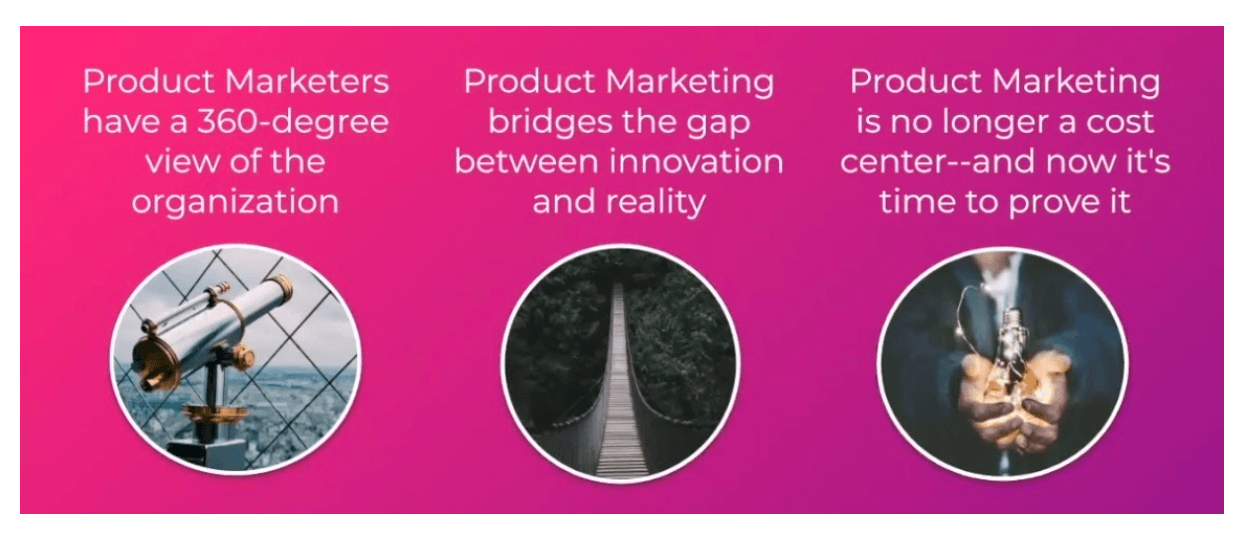
1) Product marketers have a 360-degree view of the organization
Jumping right into that idea of our unique view of the organization.
Product marketing lays the foundation for each brick in the GTM process
If you think about it, and you've ever led a go-to-market, we really lay that foundation that helps each step in that go-to-market process work.
And it’s the mortar that holds it all together
Along the way, we're bringing the teams together, and we're helping to cross the T's and dot the I's, and we're acting as that mortar that holds the whole process together from start to finish.
If you're lucky enough to have a project management team in your organization, then you probably have a partner in crime with us. But you also understand you are ultimately responsible for that successful lunch.
What is the role and value of product marketing?
I thought this was interesting when thinking about this 360-degree view. The Product Marketing Alliance interviewed 50 of the top product marketing influencers, and one of the questions they asked was, what is the role and value of product marketing in your organization?
Of course, they got a lot of different responses from these influencers. But there were some similarities that really held true across the board.
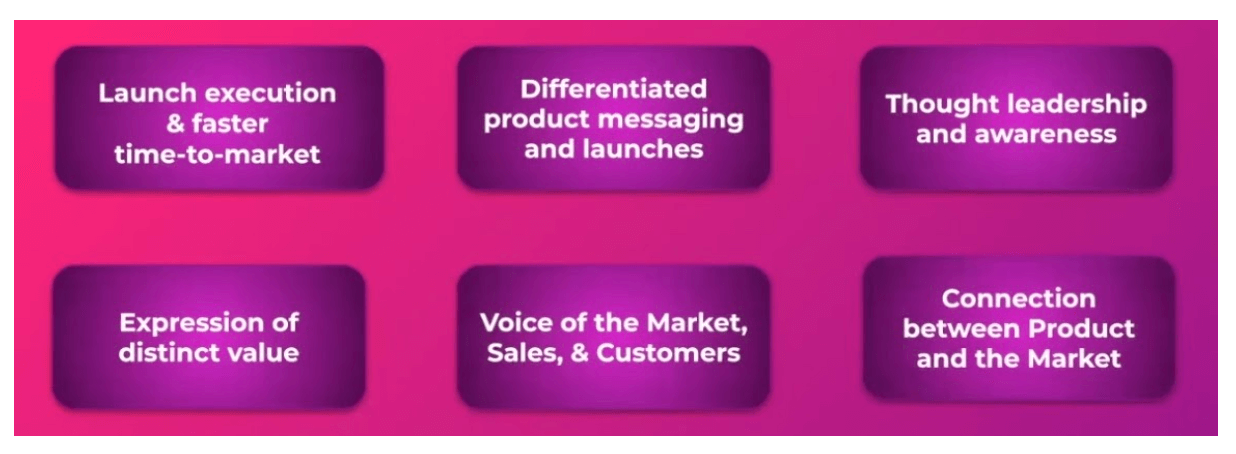
This really helps reinforce the idea that we are this glue that's holding this go-to-market together.
Launch execution and faster time to market
Not only do we help execute these projects, and get these features to market, we make sure it happens on time so the company can start recognizing that revenue earlier.
Differentiated product messaging and launches
We differentiate our product messaging and we find new ways, even if it's a product or feature we may not necessarily be so excited about and may not feel so innovative, there are still ways that we as product marketers find to tell a compelling story about what we're launching and get the market to pay attention.
Thought leadership and awareness
We're the thought leaders in the organization, the ones people go to for messaging. Questions like "how do I position this? or "how do I talk about this to my customers and prospects?" are questions typically directed at product marketers.
Then we should really be leading the charge with the analyst community and with influencers to help them understand the role of our organization in the market and how we're innovating.
Expression of distinct value
When it comes to pricing and packaging, nobody thinks of that as a very exciting piece of go-to-market but it does help set the stage for the distinct value of what we're offering and it positions it to customers and prospects appropriately.
Voice of the market, sales, and customers
We really act as the voice of the market, what the market wants and needs, we're acting as the voice of sales. Taking that feedback for why we're winning or losing deals and how we need to apply that to our roadmap.
We need to make sure our customers who give us our feedback don't slip into a black hole somewhere and are always used to inform our strategy.
The connection between product and the market
We really, in the end, make that connection between the product team and the market and make sure what we're innovating on is the right thing.
The ability to collaborate effectively across departments is a skill that is often undervalued
This is just something I wanted to point out, although we are collaborating with all of these different teams, that's a skill I think is undervalued in a lot of organizations but it's one that's necessary.
If it wasn't there, everyone would notice right away that this mortar wasn't in a place that's keeping these processes connected. Be proud of that skill.
Even when we don't necessarily feel like bringing all of these teams together and being the ones who have visibility to all of it, it plays such a critical role in your organization. It's at the heart of the strategy your teams are pulling off.
How to claim your seat
Here are a few pragmatic tips for how you can claim your seat at the strategy table, and use that 360-degree view to your advantage:
Advocate
Gain executive buy-in and support
First of all, if you don't already, get to know an executive who understands product marketing and who really believes in what you're doing as a product marketer. Take them your process ideas, take them your proof points for what's worked well in the past and get their buy-in.
Let them be your champion when you're trying to put these new processes in place and you're trying to get visibility into the strategy earlier.
Uncover pain points across teams
Before you come with your process in hand and you start to make sweeping changes, ask the teams what's going well, what's not going well? How can we make these launches better?
Listen and ask questions first
Take the time to ask them the questions that may have difficult answers so you know what really needs to be improved on.
You'll be amazed at how these cross-functional teams start to view you as an ally and an asset instead of just somebody who wants to get in the way with yet another process.
Connect with regularity
After you make these connections with the different teams, make sure you do it regularly. I know we're all so tired of meeting after meeting, but these 20 or 30-minute check-ins you have with these teams, you would be amazed at what gets uncovered in some of those cross-functional meetings.
So take the time to preserve those connections across the organization, it's well worth it.
Educate
Secondly, educate everyone.
Own your position as the go-to-market expert
If you've led go-to-markets in the past that have worked well bring those proof points and say, "Look, this isn't a process just for process sake, this will really help us accomplish our goals as an organization, it's worked in the past, it will work again".
Don’t over-engineer it
But at the same time, don't over-engineer it. Try to keep it simple, make it easy for everybody to follow along in the process and to do their part, and clearly understand what the expectations are for them.
Beat the drum
Then, of course, I know this is not news to any of you as product marketers, we have to beat the drum over and over again on what the message is, what the go-to-market plan looks like, why we're doing it this way now instead of the way it's always been done in the past.
Don't be afraid to repeat yourself and reinforce the value of what you're doing as a strategist.
Innovate
Celebrate what went well
Last but not least, celebrate what went well with each launch you do.
Keep a record of wins
Keep track of those wins, whether they're tangible wins, like product usage, or new sales that are attached to the product or feature.
Or if it's just wins like, "Hey, we launched this product on time and under budget." Make sure you're tracking that and you're taking time to celebrate it and take those proof points back to your executive champion and the executive team.
Track areas that need improvement
Then track areas where you can do a little bit better next time. This is the process, right? You don't ever do the same go-to-market twice and there's always something we can learn that will improve the next one.
Don't launch and leave
We've all had those difficult go-to-markets where we're just wanting to hit go, and then be done. But go back and take the time to explore how that product is performing in the market, how you can add new features that will bring value in the future.
It's a continuous cycle. We never really set it and forget it with our go-to-market lunches, even the difficult ones, there's always something new and something different you can do to nurture that product in the market.
2) Product marketing bridges the gap between innovation and reality
Secondly, product marketing bridges the gap between innovation and reality.
The problem with many product-first companies
This is by no means meant to be a slight on our product and engineering friends.
I've worked with some brilliant engineers and product managers in my career and I could not code my way out of a paper bag. I have absolutely nothing but respect for them and the way they approach innovation.
But I've worked at a few companies that were product-first. The problem with that is there is an assumption that you just need to build this cool technology and that's enough.

If you're not familiar with this picture, it's from the movie Field of Dreams. It came out when I was a kid, it was a really good movie, kind of weird, but a great movie, if you haven't seen it, check it out.
The whole theme of that movie was this line, 'if you build it, they will come'. The problem with some of these product-first companies is they're finding that they build it, and nobody comes. That is because you still have to take it to market even if you build it.
That's where we come in from ideation before that roadmap is even born all the way past when that product goes to market.
PMM: market research
We're in partnership with the product teams and help them stay on track with what the market needs and wants. From the very beginning that looks like customer feedback, competitive research, we're analyzing whether the right time to take this feature to market, will the market support it?
We're talking to analysts about the conversations they're having with their prospects and we're asking them is this the right time and the right approach to building this? Is there anything else we should be focusing on instead?
We're talking to our partners to hear what their customers are saying to them. As we start to build out that roadmap, this sounds very simplistic, but even something as simple as what we call a product really sets the tone for how the market responds to it.
We're looking at how will this impact our revenue? That's a number everyone from your C-suite down is going to be really interested in and it's one of those great metrics you can tie back to the value of product marketing.
PMM: pricing/packaging
We're pricing it competitively in the market. This is one some companies overlook - how we package our products and features. The goal here is to package these new technologies or these new products or features in a way that drives the most value for your customers so they're not subscribing to a package of stuff that they're not actually going to use, but it also drives the most value back to your business.
In combination with that pricing exercise, definitely take a look at how you're packaging all of these things as well.
PMM: promotion/launch
When it's time to promote and launch, you are the gatekeeper of the messaging. The messaging you create for this new product or feature sets the tone for everything, it's the baseline for your go-to-market plan, it keeps everything in scope.
It helps your sales team understand how to have these conversations when they start to sell. It helps your support teams know what the intended value is, and to make sure your customers are getting that value. Make sure that you really own the messaging, and that go-to-market plan from start to finish.
Talk to your pilot customers, if you offer pilots. Ask them how things are going. If you uncover some red flags, don't be afraid to blow the whistle and say, "Hey, we've got to shift this go-to-market date a little bit until we iron this out." There might be some short-term pain but the benefits of a successful GA launch will far outweigh that pain in the end.
This is where you create that great content and collateral that your demand generation team can use to help build a new pipeline. This is when you enable your internal teams so again, everybody is using that baseline messaging to sing from the same sheet of music about the value of this product and feature.
This is when you start to promote it to the analyst community, to the media and really position yourselves as thought leaders and innovators in the market.
PMM: beyond the launch
Last but not least, again, we don't launch and leave. Getting that customer feedback early on as customers start to adopt is really critical.
The same with your support teams and again, I think sometimes we're afraid to talk to support because sometimes they hear the worst of the worst. But that's really what we need to hear so we can help our product teams focus on the right bug fixes and the right features to add on to these new technologies so they're really serving our customers well.
And then as you start to uncover happy customers, those proof points and case studies are gold. When you start to build out your content and your collateral library, whether it's customer quotes or customer testimonials, everybody loves to hear from a customer about why our product or feature is valuable.
Don't be afraid to tweak your messaging over time. Go-to-market is never really set in stone; we have an opportunity to improve and to change the way we look at products over time.
Again, make sure you're leveraging the analyst community and you are getting the right information in the hands of the press, and you're packaging it all in a way that positions your organization as a thought leader.
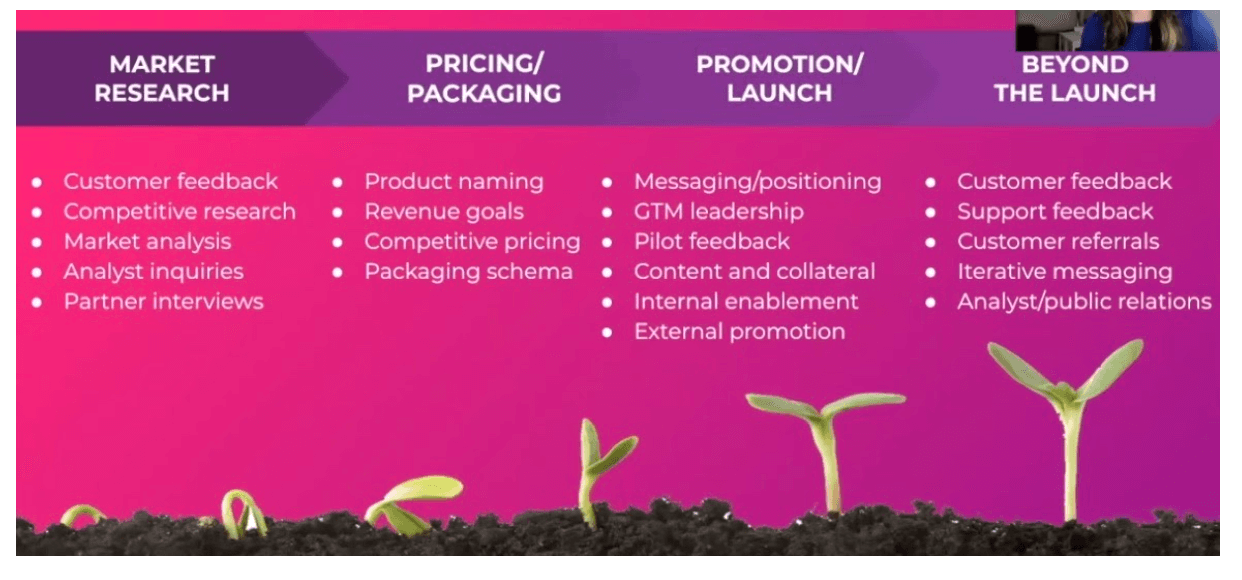
How to claim your seat
A few tips for how to do this in your organization.
Pre-launch
Leverage CAB and user groups
If you don't have a customer advisory board or user group, it's okay. You can still leverage some of your most vocal customers, you know who those people are and if you don't, your customer support teams will.
Get to know your UI/UX team
Also, get to know your UI and UX team, and ask them how people are responding to their user testing. See if there's any feedback there that you can take back to your product teams and leverage.
Interview sales and support
Interview your sales and support teams, don't be afraid of the feedback you get. These are two very vocal teams in the organization but their insight is invaluable. They have a very bird's eye view of what's going on in the market.
Win/loss analysis
If you're not already, do some win/loss analysis. If you're uncovering something recurring, a feature your product is missing, or an opportunity to iterate on something that's going really well, take that feedback to the product team before they start to build out that roadmap.
Talk to analysts
Talk to your analysts and again, leverage them as experts. They talk to a lot of prospective customers, and they can guide a lot of business to you or away from you. It definitely benefits you to get their expertise.
Visit customers
This is one that has really been a gift for me through the course of my career and I hope that we can do this again soon. Going on-site and visiting customers and sitting with your end-users and asking them:
- How is our technology helping you do your job?
- What could we do differently?
- What do you like about it?
- What's not easy to use about it?
And getting that first-hand feedback is one of the most valuable things I've ever spent time on.
Launch
Make messaging the foundation for everything
When you're in the launch process, make that messaging the foundation for everything else you do. It helps you really solidify ownership of that go-to-market plan.
Own the GTM plan and be first to deliver
As you're moving through those go-to-market activities, try to set a goal for yourself to be the first to deliver on your marketing deliverables.
I always tell my product teams when we're in the thick of it with these go-to-markets, "I promise you that when we're ready to launch you will not be waiting on marketing" and knock on wood that has been the case so far.
But as the owner of the go-to-market plan, make sure you are hitting your own deadlines and delivering when you say you will.
Talk to pilot customers
Keep talking to those pilot customers and see how things are going with this launch.
Prioritize enablement
Make sure everybody internally is enabled before you decide to go to market and launch. There's nothing support teams hate more than when something is released out into the wild and they're the last to know about it.
So really prioritize that enablement and make sure all of your teams are comfortable before you launch it.
Treat releases like your company autobiography
This is something a lot of organizations overlook. If you're an agile organization, you're releasing features kind of ad hoc, little by little, in sprints, I encourage you to take a step back, and whether it's over a quarter, over a season, look at everything you've done.
And try to map those innovations back to a theme in your organization, whether it's improved analytics, improved customer experience, and treat it like a chapter in the autobiography of your organization.
Go ahead and do those agile releases and get those features out to customers but then take a step back and adopt a seasonal release strategy that will allow you to package those features in a really innovative way that makes it easy for the market to follow your story.
Post-launch
Collect customer feedback early and often
After the launch, make sure you're collecting customer feedback.
Leverage early results for references
Collect those early results and identify those happy customers.
Perfect the message & generate new content
Continue to refine the message and generate new content as you get those case studies and proof points.
Measure performance
Then measure everything as you go. Don't be afraid to put notes and comments directly in your go-to-market tracker so you can map those successes directly back to your go-to-market plan.
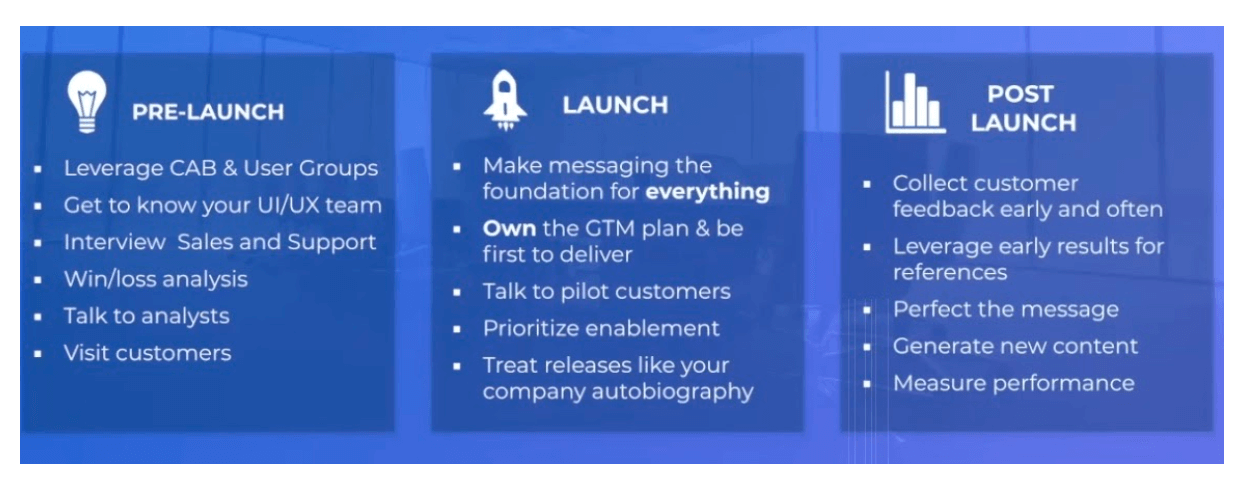
3) Product marketing is no longer a cost center - and now it’s time to prove it
Last but not least, product marketing is no longer a cost center, and here's why.
Beth Comstock, who is a former vice-chair at GE said this and it really rings true, "You can't sell anything if you can't tell anything".
A lot of times as product marketers, I think we get written off as just the storytellers and the soft skills of the organization. That couldn't be farther from the truth.
Product marketing closes the value loop
We help in closing the value loop through the market research that we provide and making sure this is something that will succeed in the market.
We are pricing and packaging in a way that gets attention when we go to market. You really only get one first impression and if you don't get pricing and packaging right, it is going to limit your growth.
We are the owners and the gatekeepers of that messaging and positioning, you can't launch or tell a story without the messaging and positioning. And as you start to deliver that to the market, it is one of the earliest predictors of success.
Again, we are the go-to-market owners who help deliver these launches on time so we can start recognizing revenue earlier.
As we move past the launch, we're continuing to nurture these products in the market to ensure their continued success.
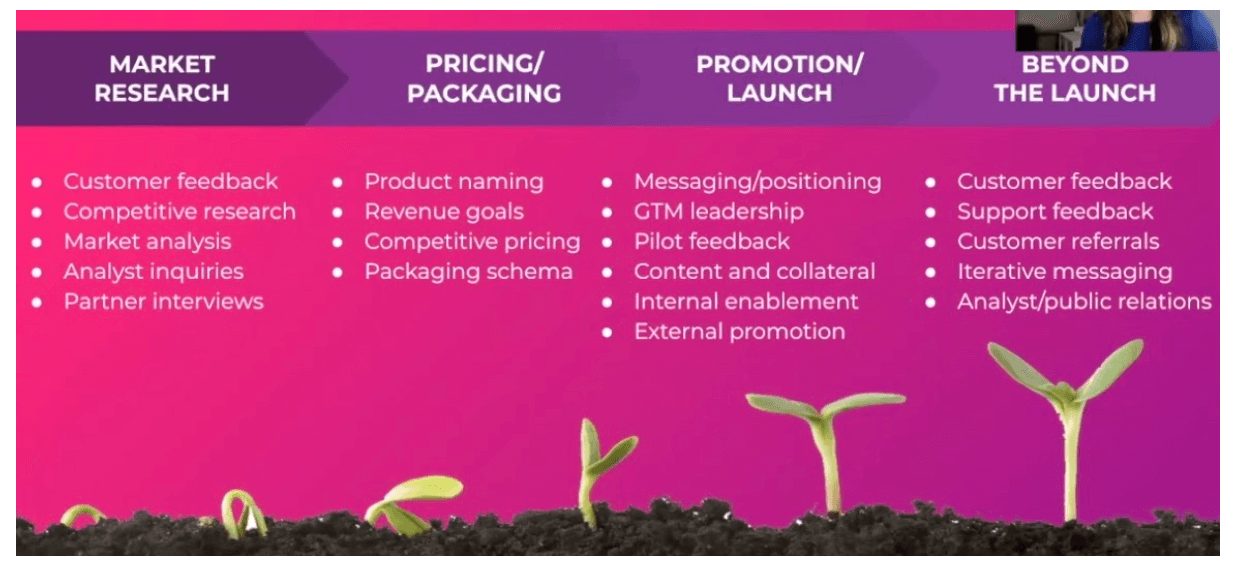
How to claim your seat
A few helpful tips for doing this.
Plan
Determine what success means for each launch
Before you launch anything, determine what that measure of success means for you. At the end of this go-to-market, what will success look like for you? Then set those goals for yourself.
Set reasonable revenue impact targets
Also set those revenue impact targets so you can tell your finance teams, "Hey, as a result of this on-time go-to-market, here's how we impacted our revenue stream and our pipeline".
Push back on blockers or red flags in the market
Again, push back if you see any red flags, and you need to delay your go-to-market, don't be afraid to speak up and say so.
Execute
As you start to execute with your go-to-market plan in hand, stay engaged with the different teams, over-communicate on who's falling a little bit behind, and try to help them meet their deliverables on time.
We all know if one person gets a little off track in a go-to-market, it can really derail the whole thing. So really over-communicate and check in with your teams with regularity.
Don't forget to preview your release with the analysts and with influencers, whether it's an embargoed press release, or you're just checking in with them on an inquiry to say, "Hey, we're getting ready to release this to market", it's a great way to get them to write about it and to talk about it and to talk to their prospective clients once you do launch it.
Measure
In the measure column, I added a few of the many, many metrics that as product marketers, we can track directly back to go-to-market, and the impact that we have on revenue.
Don't be afraid to measure these tangible things. We don't have to measure and soft skills anymore. We have the right technologies and tools in place to really indirectly tie what we do as those cross collaborators across the organization back to how our company is performing.
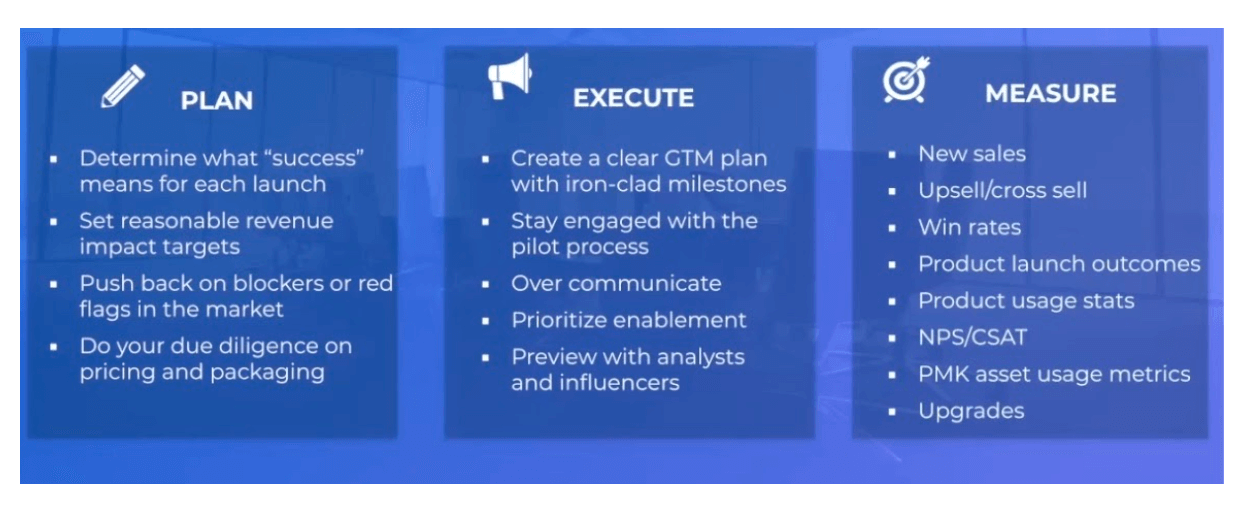
Why do you belong at the strategy table?
I want to leave you with this thought. The best thing that you can do to get that seat at the table is to just own it and believe that you deserve it.
If there's one thing that we've all learned, it's that the best way to exact change is to look at things a little bit differently and don’t be afraid to break out of the familiarity of 'that's the way we've always done it'.
I would encourage each of you to take a step back in your organization and look at some of these tips and tools that you can implement with your cross-functional teams and really step up to the plate as the strategists that you are.
Thank you.


















 Follow us on LinkedIn
Follow us on LinkedIn




.svg)
Start the conversation
Become a member of Product Marketing Alliance to start commenting.
Sign up now